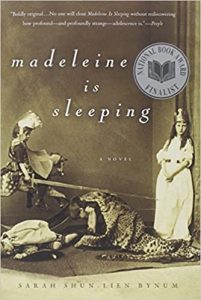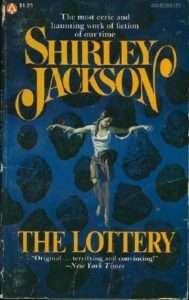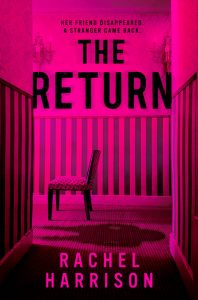A teenage girl walks alone along a deserted country road. The sun is just beginning to dip beneath a distant horizon, and the sky above her purples like a bruise. There’s a sound. The growing hum of an engine. A pickup truck is approaching. The girl sticks out her thumb, and the truck slows.
From here, a number of things could happen. Our dread informs us that none of them are good. Dread is at the core of all dark fiction, whether it be thriller, psychological suspense, mystery, crime, or horror. Dread compels us to keep reading, to keep watching. To look even though we know we won’t like what we see.
Dread is at the core of all dark fiction…Dread compels us to keep reading, to keep watching. To look even though we know we won’t like what we see.As a woman, I have a very specific, very complicated relationship with dread. I remember seeing JonBenét Ramsey’s face on the cover of People magazine as a kid and thinking, she’s my age, and she’s dead! That means I could be dead! I remember reading the article. Nylon cord. Strangulation. It awakened me to the reality of violence. It introduced me to my dread.
My dread compelled me to keep reading, to keep watching. There’s no shortage of stories about violence against women, and violence comes in many forms. At times, my dread has made me smart. It’s put me in a car late at night instead of walking. It’s told me to take out my earbuds and pay attention to my surroundings. Other times, my dread feels like a burden. Relentless and debilitating and, worst of all, powerless. My dread alone cannot keep me safe.
Still, I seek dread wherever I can find it. My favorite way to explore dread is through fiction, particularly short fiction. There’s such little time to cultivate dread in a short story that not a second can be wasted. Without room for a slow burn, the story must be efficient. Each of these five brilliant stories is an extraordinary example of how to wield dread in short fiction, and each of the five brilliant women who wrote them has a profound understanding of dread. Something bad is about to happen, and whatever is coming, is coming quickly.

“Where Are You Going, Where Have You Been?” by Joyce Carol Oates
Fifteen-year-old Connie is a lot like most fifteen-year-old girls. She’s obsessed with her appearance, wants to be an adult, resents her mother, and hangs out with older boys behind her parent’s backs. I can’t remember how old I was when I first learned about what it meant to be “asking for it”, I only know that I did, that my friends did, and that despite the notion being ludicrous, it’s often cited as justification for the atrocities done to women. In this story, beautiful young Connie in her shorts and ballet flats, with her long blonde hair and carefree giggle, is naïve about the dangers of the world. As readers, we are not. That’s where the dread in this story is born. When the boy in the gold convertible tells Connie, “Gonna get you, baby” and Connie walks off without a second thought, we—the reader —are still thinking about it. Because we believe him. We know what the world is like. So, we keep reading, waiting for horrifying confirmation. For true crime buffs, this story was inspired by The Pied Piper of Tucson. This story has been frequently anthologized, a quick Google search can lead you to a copy.

“The Man on the Stairs” by Miranda July
As someone who struggles with anxiety, I often anticipate bad things happening, so often that when something bad actually does happen and I’m confronted with the reality, I go through waves of complete disbelief. That’s the thing about dread. It can warn us, but it does not prepare us. The title of this story is foreboding, but in combination with the opening lines, it becomes downright terrifying. “The Man on the Stairs” is about a woman lying in bed next to her sleeping boyfriend, listening to someone coming up the stairs. An intruder. She knows she’s in immediate danger, and yet her thoughts wander. There’s something so relatable about her not knowing what to do in a moment of crisis, so human about her not quite being able to accept the grim reality of her circumstance, that we too are disoriented in panic, we too are distracted from the immediate danger. Until we aren’t. This story is a magic trick. It’ll saw you in half. You can read it here.

“The Erlking” by Sarah Shun-Lien Bynum
This story is about stressed-out mother Kate and her young daughter Ondine. The two are exploring the Elves’ Faire at the Waldorf school, which specializes in “child-initiated learning” and activities like candle making and beekeeping. Despite the story taking place in present day, the dreamy fairy tale/Ren-faire atmosphere hints at the possibility of enchantment. But not all is sunshine and rainbows and basket weaving at the Elves’ Faire. Kate and Ondine are not in sync. Ondine, who insists on being called Ruthie, is tired and wants to dance but also maybe has to go potty. Kate is preoccupied thinking about how she didn’t send in an application for Ruthie to go to this school, and how maybe that was a mistake. As the perspective switches back and forth between Kate and Ruthie, it’s clear they’re drifting in opposite directions. The space between them allows the dread to creep in. The genius of Sarah Shun-Lien Bynum’s story is in the rich details of the setting. The flower wreaths, the ribbons and tunics, the mandolin music in the distance. The juxtaposition of a fairy tale setting with a mother and daughter who are unaware of how they are failing each other is exquisitely unnerving. When the story veers into darker territory, it’s hardly surprising, and yet somehow, it’s surprising. You can read it here.

“The Husband Stitch” by Carmen Maria Machado
I first heard the story about the woman with the green ribbon around her neck in elementary school from a friend anxious to traumatize me. I’m sure you’re familiar. Most of the time, when we already know how something ends, we become immune to dread. Most of the time, dread comes from knowing something bad is going to happen, but not being sure what exactly that bad thing is. Once we know, what is there to be afraid of? Carmen Maria Machado, a supreme talent, instead uses the fact that we already know the ending to the story of the woman with the green ribbon around her neck to exhume…surprise! More dread! “The Husband Stitch” is told in the first person from the woman’s perspective. We’re with her on her journey, we feel what she’s feeling, and the closer we get to her, the more devastating the inevitable end becomes. You can read it here.

“The Lottery” by Shirley Jackson
This story takes place on a seemingly ordinary day in early summer, in an ordinary village, where the villagers are preparing for the lottery. This lottery is at the center of all of the action taking place. The villagers are preoccupied with it. But what is it, exactly? As readers, not knowing what the lottery is piques our curiosity. Soon, the mystery of the lottery transforms that curiosity into dread. Why aren’t we being told? There has to be a reason, right? Shirley Jackson, Queen of dread, expertly builds it here by withholding the true nature of the lottery, and the story, until the very end. This story is essentially the dread equivalent of someone telling you “we need to talk” and then adding “I’ll call you tomorrow.” You can read it here.
*


















